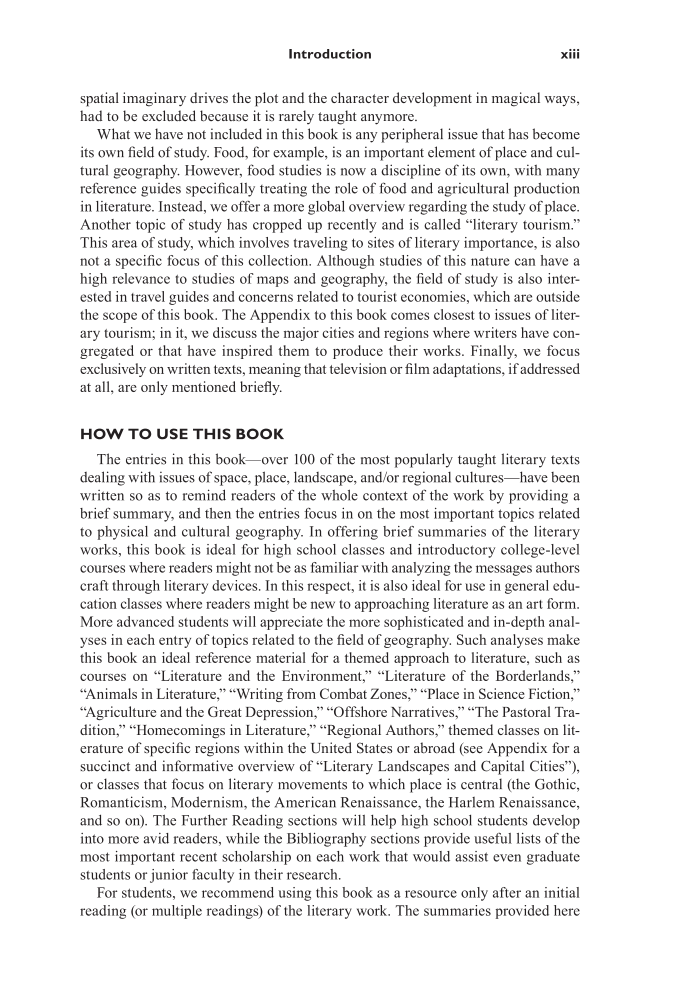Introduction xiii spatial imaginary drives the plot and the character development in magical ways, had to be excluded because it is rarely taught anymore. What we have not included in this book is any peripheral issue that has become its own field of study. Food, for example, is an impor tant ele ment of place and cul- tural geography. However, food studies is now a discipline of its own, with many reference guides specifically treating the role of food and agricultural production in lit er a ture. Instead, we offer a more global overview regarding the study of place. Another topic of study has cropped up recently and is called “literary tourism.” This area of study, which involves traveling to sites of literary importance, is also not a specific focus of this collection. Although studies of this nature can have a high relevance to studies of maps and geography, the field of study is also inter- ested in travel guides and concerns related to tourist economies, which are outside the scope of this book. The Appendix to this book comes closest to issues of liter- ary tourism in it, we discuss the major cities and regions where writers have con- gregated or that have inspired them to produce their works. Fi nally, we focus exclusively on written texts, meaning that tele vi sion or film adaptations, if addressed at all, are only mentioned briefly. HOW TO USE THIS BOOK The entries in this book— over 100 of the most popularly taught literary texts dealing with issues of space, place, landscape, and/or regional cultures— have been written so as to remind readers of the whole context of the work by providing a brief summary, and then the entries focus in on the most important topics related to physical and cultural geography. In offering brief summaries of the literary works, this book is ideal for high school classes and introductory college-level courses where readers might not be as familiar with analyzing the messages authors craft through literary devices. In this respect, it is also ideal for use in general edu- cation classes where readers might be new to approaching lit er a ture as an art form. More advanced students will appreciate the more sophisticated and in-depth anal- yses in each entry of topics related to the field of geography. Such analyses make this book an ideal reference material for a themed approach to lit er a ture, such as courses on “Lit er a ture and the Environment,” “Lit er a ture of the Borderlands,” “Animals in Lit er a ture,” “Writing from Combat Zones,” “Place in Science Fiction,” “Agriculture and the Great Depression,” “Offshore Narratives,” “The Pastoral Tra- dition,” “Homecomings in Literature,” “Regional Authors,” themed classes on lit er a ture of specific regions within the United States or abroad (see Appendix for a succinct and informative overview of “Literary Landscapes and Capital Cities”), or classes that focus on literary movements to which place is central (the Gothic, Romanticism, Modernism, the American Renaissance, the Harlem Renaissance, and so on). The Further Reading sections will help high school students develop into more avid readers, while the Bibliography sections provide useful lists of the most impor tant recent scholarship on each work that would assist even graduate students or junior faculty in their research. For students, we recommend using this book as a resource only after an initial reading (or multiple readings) of the literary work. The summaries provided here
Document Details My Account Print multiple pages
Print
You have printed 0 times in the last 24 hours.
Your print count will reset on at .
You may print 0 more time(s) before then.
You may print a maximum of 0 pages at a time.

























































































































































































































































































































































































































